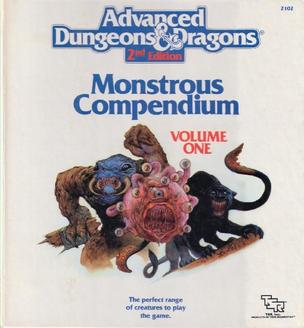Related Research Articles

Spelljammer is a campaign setting originally published for the Advanced Dungeons & Dragons role-playing game, which features a fantastic outer space environment. Subsequent editions have included Spelljammer content; a Dungeons & Dragons 5th edition setting update was released on August 16, 2022.
The beholder is a fictional monster in the Dungeons & Dragons fantasy role-playing game. It is depicted as a floating orb of flesh with a large mouth, single central eye, and many smaller eyestalks on top with powerful magical abilities.

The Monstrous Compendium is a series of accessories for the Advanced Dungeons & Dragons fantasy role-playing game released from 1989 to 1998. The title was then used for a series of 5th Edition Dungeons & Dragons supplements released on D&D Beyond.
Jeff Grubb is an author of novels, short stories, and comics, as well as a computer and role-playing game designer in the fantasy genre. Grubb worked on the Dragonlance campaign setting under Tracy Hickman, and the Forgotten Realms setting with Ed Greenwood. His written works include The Finder's Stone Trilogy, the Spelljammer and Jakandor campaign settings, and contributions to Dragonlance and the computer game Guild Wars Nightfall (2006).
Richard Baker is an American author and game designer who has worked on many Dungeons & Dragons campaign settings.
Trolls are fictional monsters in the Dungeons & Dragons roleplaying game.
In the Dungeons & Dragons fantasy role-playing game, the mimic is a type of fictional monster. It is portrayed as being able to change its shape to disguise its body as an inanimate object, commonly a chest. The mimic uses a powerful adhesive that holds fast to creatures that touch it, allowing the mimic to beat its victims with its powerful pseudopods. The mimic was introduced in the first edition Advanced Dungeons & Dragons game's original Monster Manual. The mimic has appeared in subsequent editions. Several variants of the creature have been introduced, with a variety of abilities and sizes.

In the Dungeons & Dragons role-playing game, orcs are a primitive race of savage, bestial, barbaric humanoid.

In the Dungeons & Dragons fantasy role-playing game, the centaur is a large monstrous humanoid. Based upon the centaurs of Greek myth, a centaur in the game resembles a human with the lower body of a horse.

In the Dungeons & Dragons fantasy role-playing game, giants are a collection of very large humanoid creatures based on giants of legend, or in third edition, a "creature type".
The lich is an undead creature found in the Dungeons & Dragons (D&D) fantasy role-playing game. Liches are spellcasters who seek to defy death by magical means.
In the Dungeons & Dragons fantasy role-playing game, a vampire is an undead creature. A humanoid or monstrous humanoid creature can become a vampire, and looks as it did in life, with pale skin, haunting red eyes, and a feral cast to its features. A new vampire is created when another vampire drains the life out of a living creature. Its depiction is related to those in the 1930s and 1940s Hollywood Dracula and monster movies. In writing vampires into the game, as with other creatures arising in folklore, the authors had to consider what elements arising in more recent popular culture should be incorporated into their description and characteristics.

Newton H. Ewell is an artist whose work has appeared in role-playing games.

Bruce Nesmith is a game designer who has worked primarily on role-playing games. He was Creative Director at TSR, working on a variety of games including Dungeons & Dragons, and is a senior game designer at Bethesda Game Studios, where he has worked on AAA titles such as Fallout 3, Fallout 4 and Elder Scrolls IV: Oblivion, and was lead designer on Elder Scrolls V: Skyrim.
Andria Hayday is a game designer who has worked primarily on role-playing games.
Gary L. Thomas is a game designer who has worked primarily on role-playing games.
Rick Swan is a game designer and author who worked for TSR. His work for TSR, mostly for Advanced Dungeons & Dragons, appeared from 1989 to 1995.
William W. Connors is a game designer who has worked primarily on role-playing games.
Dale A. Donovan is a game designer who has worked primarily on role-playing games.
References
- ↑ Shannon Appelcline (2011). Designers & Dragons. Mongoose Publishing. p. 26. ISBN 978-1-907702-58-7.